Improving Urban Habitat Connectivity for Native Birds: Using Least-Cost Path Analyses to Design Urban Green Infrastructure Networks
Abstract
1. Introduction
2. Materials and Methods
2.1. Study Area and Species
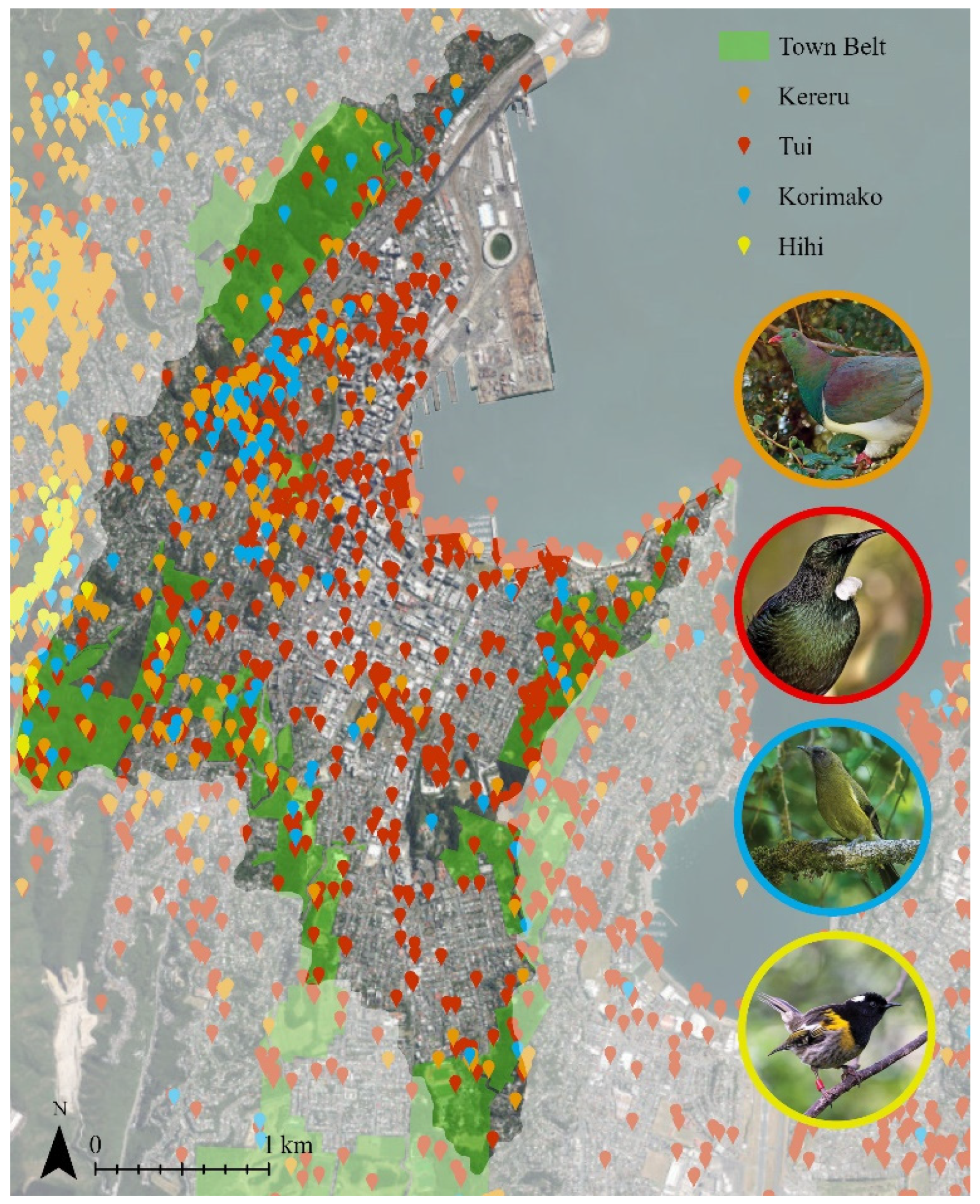
2.2. Linkage Mapper
3. Results
3.1. Kererū
3.2. Tūī
3.3. Korimako
3.4. Hihi
4. Discussion
4.1. Linkage Pathways Results
4.2. Related Habitat Connectivity Analyses
4.3. Future Research
5. Conclusions
Author Contributions
Funding
Institutional Review Board Statement
Data Availability Statement
Acknowledgments
Conflicts of Interest
References
- United Nations, Department of Economic and Social Affairs, Population Division. World Urbanization Prospects: The 2018 Revision (ST/ESA/SER.A/420); United Nations: New York, NY, USA, 2019; pp. 1–126. Available online: https://population.un.org/wup/Publications/Files/WUP2018-Report.pdf (accessed on 30 May 2023).
- zu Ermgassen, S.O.S.E.; Utamiputri, P.; Bennun, L.; Edwards, S.; Bull, J.W. The Role of “No Net Loss” Policies in Conserving Biodiversity Threatened by the Global Infrastructure Boom. One Earth 2019, 1, 305–315. [Google Scholar] [CrossRef]
- McKinney, M. Effects of urbanisation on species richness: A review of plants and animals. Urban Ecosyst. 2008, 11, 161–176. [Google Scholar] [CrossRef]
- Mcdonald, R.; Kareiva, P.; Forman, R. The implications of current and future urbanisation for global protected areas and biodiversity conservation. Biol. Conserv. 2008, 141, 1695–1703. [Google Scholar] [CrossRef]
- Dupras, J.; Marull, J.; Parcerisas, L.; Coll, F.; Gonzalez, A.; Girard, M.; Tello, E. The impacts of urban sprawl on ecological connectivity in the Montreal Metropolitan Region. Environ. Sci. Policy 2016, 58, 61–73. [Google Scholar] [CrossRef]
- Tzoulas, K.; Korpela, K.; Venn, S.; Yli-Pelkonen, V.; Kaźmierczak, A.; Niemela, J.; Philip, J. Promoting ecosystem and human health in urban areas using Green Infrastructure: A literature review. Landsc. Urban Plan. 2007, 81, 167–178. [Google Scholar] [CrossRef]
- Botzat, A.; Fischer, L.; Kowarik, I. Unexploited opportunities in understanding liveable and biodiverse cities. A review on urban biodiversity perception and valuation. Glob. Environ. Chang. 2016, 39, 220–233. [Google Scholar] [CrossRef]
- Dadvand, P.; Bartoll, X.; Basagaña, X.; Dalmau-Bueno, A.; Martinez, D.; Ambros, A.; Cirach, M.; Triguero-Mas, M.; Gascon, M.; Borrell, C.; et al. Green spaces and general health: Roles of mental health status, social support, and physical activity. Environ. Int. 2016, 91, 161–167. [Google Scholar] [CrossRef]
- Vargas-Hernández, J.; Pallagst, K.; Zdunek-Wielgołaska, J. Urban green spaces as a component of an ecosystem. In Handbook of Engaged Sustainability; Marques, J., Ed.; Springer International Publishing: New York, NY, USA, 2018; pp. 885–916. [Google Scholar] [CrossRef]
- Weisser, W.W.; Hensel, M.; Barath, S.; Culshaw, V.; Grobman, Y.J.; Hauck, T.E.; Joschinski, J.; Ludwig, F.; Mimet, A.; Perini, K.; et al. Creating ecologically sound buildings by integrating ecology, architecture and computational design. People Nat. 2023, 5, 4–20. [Google Scholar] [CrossRef]
- Wang, L.; Wang, H.; Wang, Y.; Che, Y.; Ge, Z.; Mao, L. The relationship between green roofs and urban biodiversity: A systematic review. Biodivers. Conserv. 2022, 31, 1771–1796. [Google Scholar] [CrossRef]
- Filazzola, A.; Shrestha, N.; MacIvor, J.S.; Stanley, M. The contribution of constructed green infrastructure to urban biodiversity: A synthesis and meta-analysis. J. Appl. Ecol. 2019, 56, 2131–2143. [Google Scholar] [CrossRef]
- Braaker, S.; Ghazoul, J.; Obrist, M.K.; Moretti, M. Habitat connectivity shapes urban arthropod communities: The key role of green roofs. Ecology 2014, 95, 1010–1021. [Google Scholar] [CrossRef]
- Wooster, E.I.F.; Fleck, R.; Torpy, F.; Ramp, D.; Irga, P.J. Urban green roofs promote metropolitan biodiversity: A comparative case study. Build. Environ. 2022, 207, 108458. [Google Scholar] [CrossRef]
- Baumann, N.; Catalano, C.; Pasta, S. Improving Extensive Green Roofs for Endangered Ground-Nesting Birds. In Urban Services to Ecosystems; Catalano, C., Andreucci, M.B., Guarino, R., Bretzel, F., Leone, M., Pasta, S., Eds.; Springer Nature: Cham, Swirzerland, 2021; Volume 17, pp. 13–29. [Google Scholar] [CrossRef]
- Partridge, D.R.; Clark, J.A. Urban green roofs provide habitat for migrating and breeding birds and their arthropod prey. PLoS ONE 2018, 13, e0202298. [Google Scholar] [CrossRef]
- Belcher, R.N.; Sadanandan, K.R.; Goh, E.R.; Chan, J.Y.; Menz, S.; Schroepfer, T. Vegetation on and around large-scale buildings positively influences native tropical bird abundance and bird species richness. Urban Ecosyst. 2019, 22, 213–225. [Google Scholar] [CrossRef]
- Catalano, C.; Balducci, A. Environmental analysis and ecosystemic design: Survey, critical issues and application solutions. Agathón 2022, 11, 246–257. [Google Scholar] [CrossRef]
- Venter, Z.S.; Barton, D.N.; Martinez-Izquierdo, L.; Langemeyer, J.; Baró, F.; McPhearson, T. Interactive spatial planning of urban green infrastructure—Retrofitting green roofs where ecosystem services are most needed in Oslo. Ecosyst. Serv. 2021, 50, 101314. [Google Scholar] [CrossRef]
- Langemeyer, J.; Wedgwood, D.; McPhearson, T.; Baró, F.; Madsen, A.L.; Barton, D.N. Creating urban green infrastructure where it is needed—A spatial ecosystem service-based decision analysis of green roofs in Barcelona. Sci. Total Environ. 2020, 707, 135487. [Google Scholar] [CrossRef]
- Mora-Melià, D.; López-Aburto, C.S.; Ballesteros-Pérez, P.; Muñoz-Velasco, P. Viability of Green Roofs as a Flood Mitigation Element in the Central Region of Chile. Sustainability 2018, 10, 1130. [Google Scholar] [CrossRef]
- Twohig, C.; Casali, Y.; Aydin, N.Y. Can green roofs help with stormwater floods? A geospatial planning approach. Urban Urban Green. 2022, 76, 127724. [Google Scholar] [CrossRef]
- Viecco, M.; Jorquera, H.; Sharma, A.; Bustamante, W.; Fernando, H.J.S.; Vera, S. Green roofs and green walls layouts for improved urban air quality by mitigating particulate matter. Build. Environ. 2021, 204, 108120. [Google Scholar] [CrossRef]
- Hirano, Y.; Ihara, T.; Gomi, K.; Fujita, T. Simulation-Based Evaluation of the Effect of Green Roofs in Office Building Districts on Mitigating the Urban Heat Island Effect and Reducing CO2 Emissions. Sustainability 2019, 11, 2055. [Google Scholar] [CrossRef]
- Adriaensen, F.; Chardon, J.P.; De Blust, G.; Swinnen, E.; Villalba, S.; Gulinck, H.; Matthysen, E. The application of “least-cost” modelling as a functional landscape model. Landsc. Urban Plan. 2003, 64, 233–247. [Google Scholar] [CrossRef]
- Balbi, M.; Petit, E.J.; Croci, S.; Nabucet, J.; Georges, R.; Madec, L.; Ernoult, A. Ecological relevance of least cost path analysis: An easy implementation method for landscape urban planning. J. Environ. Manag. 2019, 244, 61–68. [Google Scholar] [CrossRef]
- McRae, B.H.; Kavanagh, D.M. Linkage Mapper Toolbox: Linkage Pathways Tool User Guide, 3rd ed.; The Nature Conservancy: Seattle, WA, USA, 2011; pp. 1–22. Available online: https://linkagemapper.org/Downloads/ (accessed on 30 May 2023).
- Linkage Mapper Connectivity Analysis Software. Available online: https://linkagemapper.org/ (accessed on 30 May 2023).
- Ding, Z.; Cao, J.; Wang, Y. The Construction and Optimization of Habitat Networks for Urban–Natural Symbiosis: A Case Study of the Main Urban Area of Nanjing. Forests 2023, 14, 133. [Google Scholar] [CrossRef]
- Fagan, M.E.; DeFries, R.S.; Sesnie, S.E.; Arroyoâ-Mora, J.P.; Chazdon, R.L. Targeted reforestation could reverse declines in connectivity for understory birds in a tropical habitat corridor. Ecol. Appl. 2016, 26, 1456–1474. [Google Scholar] [CrossRef]
- Colyn, R.B.; Smith, D.A.E.; Smith, Y.C.E.; Smit-Robinson, H.; Downs, C.T. Predicted distributions of avian specialists: A framework for conservation of endangered forests under future climates. Divers. Distrib. 2020, 26, 652–667. [Google Scholar] [CrossRef]
- Lopez, B.E.; Urban, D.; White, P.S. Nativity and seed dispersal mode influence species’ responses to habitat connectivity and urban environments. Glob. Ecol. Biogeogr. 2018, 27, 1017–1030. [Google Scholar] [CrossRef]
- Kong, F.; Wang, D.; Yin, H.; Dronova, I.; Fei, F.; Chen, J.; Pu, Y.; Li, M. Coupling urban 3-D information and circuit theory to advance the development of urban ecological networks. Conserv. Biol. 2021, 35, 1140–1150. [Google Scholar] [CrossRef]
- Alshafei, I.; Righelato, P.U. The Human Ecosystem Spatial Networks of Amman City Center: A New Methodological Approach towards Resiliency. Sustainability 2022, 14, 8451. [Google Scholar] [CrossRef]
- Parlato, E.H.; Armstrong, D.P.; Innes, J.G. Traits influencing range contraction in New Zealand’s endemic forest birds. Oecologia 2015, 179, 319–328. [Google Scholar] [CrossRef]
- Department of Conservation. Te Mana o Te Taiao—Aotearoa New Zealand Biodiversity Strategy; Department of Conservation: Wellington, New Zealand, 2020; pp. 1–73. Available online: https://www.doc.govt.nz/globalassets/documents/conservation/biodiversity/anzbs-2020.pdf (accessed on 30 May 2023).
- Predator Free NZ. Available online: https://predatorfreenz.org/ (accessed on 30 May 2023).
- Statistics New Zealand. Census Place Summaries: Wellington City. 2018. Available online: https://www.stats.govt.nz/tools/2018-census-place-summaries/wellington-city#more-data-and-information (accessed on 30 May 2023).
- Wellington City Council. Our Natural Capital: Wellington’s Biodiversity Strategy and Action Plan; Wellington City Council: Wellington, New Zealand, 2015; pp. 1–116. Available online: https://wellington.govt.nz/~{}/media/your-council/plans-policies-and-bylaws/plans-and-policies/a-to-z/biodiversity/files/2015/our-natural-capital-entire.pdf?la=en (accessed on 30 May 2023).
- Biophilic Cities. Available online: https://www.biophiliccities.org/wellington (accessed on 30 May 2023).
- Blaschke, P.; Chapman, R.; Gyde, E.; Howden-Chapman, P.; Ombler, J.; Pedersen Zari, M.; Perry, M.; Randal, R. Green Space in Wellington’s Central City: Current Provision, and Design for FutureWellbeing; New Zealand Centre for Sustainable Cities: Wellington, New Zealand, 2019; pp. 1–96. Available online: https://www.sustainablecities.org.nz/sites/default/files/2021-12/Report-Green-Space-in-Wellington%E2%80%99s-Central-City.pdf (accessed on 30 May 2023).
- Wellington City Council. Long-Term Plan 2018-28; Wellington City Council: Wellington, New Zealand, 2018; pp. 1–236. Available online: https://wellington.govt.nz/-/media/your-council/plans-policies-and-bylaws/plans-and-policies/longtermplan/2018-28/wcclong-term-plan-2018-28-volume-1.pdf?la=en&hash=07BACEFF739B18327D43E67F890E895CC7A68E5A (accessed on 30 May 2023).
- Klem, D.; Farmer, C.J.; Delacretaz, N.; Gelb, Y.; Saenger, P.G. Architectural and Landscape Risk Factors Associated with Bird–glass Collisions in an Urban Environment. Wilson J. Ornithol. 2009, 121, 126–134. [Google Scholar] [CrossRef]
- Snep, R.; Kooijmans, J.; Kwak, R.; Foppen, R.P.; Parsons, H.; Awasthy, M.; Sierdsema, H.; Marzluff, J.; Fernandez-Juricic, E.; Laet, J.; et al. Urban bird conservation: Presenting stakeholder-specific arguments for the development of bird-friendly cities. Urban Ecosyst. 2016, 19, 1535–1550. [Google Scholar] [CrossRef]
- De Montis, A.; Caschili, S.; Mulas, M.; Modica, G.; Ganciu, A.; Bardi, A.; Ledda, A.; Dessena, L.; Laudari, L.; Fichera, C.R. Urban–rural ecological networks for landscape planning. Land Use Policy 2016, 50, 312–327. [Google Scholar] [CrossRef]
- Gharibi, S.; Shayesteh, K.; Attaeian, B. Interconnected ecological network design using lcp algorithm and cohesion index in urban scale. Urban Ecosyst. 2021, 24, 153–163. [Google Scholar] [CrossRef]
- Rastandeh, A.; Pedersen Zari, M. A spatial analysis of land cover patterns and its implications for urban avifauna persistence under climate change. Landsc. Ecol. 2018, 33, 455–474. [Google Scholar] [CrossRef]
- Payton, I.; Fenner, M.; Lee, W. Keystone species: The concept and its relevance for conservation management in New Zealand. In Science for Conservation 203; Clelland, L., Ed.; Department of Conservation: Wellington, New Zealand, 2002; pp. 1–29. Available online: https://www.doc.govt.nz/documents/science-and-technical/sfc203.pdf (accessed on 30 May 2023).
- Meurk, C.; Sullivan, J.; McWilliam, W. Vegetation History and Dynamics in New Zealand: Future Scenarios and Improved Trajectories Towards Restoring Natural Patterns. In Vegetation Structure and Function at Multiple Spatial, Temporal and Conceptual Scales, 1st ed.; Box, E., Ed.; Springer International Publishing: Cham, Switzerland, 2016; pp. 517–528. [Google Scholar] [CrossRef]
- Powlesland, R.G. Kererū New Zealand pigeon. In New Zealand Birds Online; Miskelly, C.M., Ed.; Te Papa: Wellington, New Zealand, 2022; Available online: https://www.nzbirdsonline.org.nz/species/new-zealand-pigeon (accessed on 30 May 2023).
- Nguyen, T.T.; Meurk, C.; Benavidez, R.; Jackson, B.; Pahlow, M. The Effect of Blue-Green Infrastructure on Habitat Connectivity and Biodiversity: A Case Study in the Otakaro/Avon River Catchment in Christchurch, New Zealand. Sustainability 2021, 13, 6732. [Google Scholar] [CrossRef]
- Robertson, H.A. Tūī. In New Zealand Birds Online; Miskelly, C.M., Ed.; Te Papa: Wellington, New Zealand, 2022; Available online: https://www.nzbirdsonline.org.nz/species/tui (accessed on 30 May 2023).
- Sagar, P.M. Bellbird korimako. In New Zealand Birds Online; Miskelly, C.M., Ed.; Te Papa: Wellington, New Zealand, 2022; Available online: https://nzbirdsonline.org.nz/species/bellbird (accessed on 30 May 2023).
- Castro, I. Hihi stitchbird. In New Zealand Birds Online; Miskelly, C.M., Ed.; Te Papa: Wellington, New Zealand, 2022; Available online: https://nzbirdsonline.org.nz/species/stitchbird (accessed on 30 May 2023).
- Eagle Technology. New Zealand Imagery. 2022. Available online: https://www.arcgis.com/home/item.html?id=d284729222d04a3cb548cfe27716ea43 (accessed on 30 May 2023).
- Spragg, B. Kereru NZ Wood Pigeon. Wikimedia Commons. 2016. Available online: https://commons.wikimedia.org/wiki/File:Kereru._NZ_Wood_Pigeon._(25446646940).jpg (accessed on 30 May 2023).
- Spragg, B. The Tui New Zealand. Wikimedia Commons. 2010. Available online: https://commons.wikimedia.org/wiki/File:The_Tui_New_Zealand._(9157585500).jpg (accessed on 30 May 2023).
- Veronesi, F. New Zealand Bellbird. Wikimedia Commons. 2017. Available online: https://commons.wikimedia.org/wiki/File:New_Zealand_Bellbird_-_New_Zealand_(24443084277).jpg (accessed on 30 May 2023).
- Miller, J. Male hihi Stitchbird. Wikimedia Commons. 2019. Available online: https://commons.wikimedia.org/wiki/File:Male_hihi_-_stitchbird.jpg (accessed on 30 May 2023).
- Global Biodiversity Information Facility. Hemiphaga Novaeseelandiae GBIF Occurrence Download. GBIF.org. 2023. Available online: https://doi.org/10.15468/dl.mqszyr (accessed on 29 May 2023).
- Global Biodiversity Information Facility. Prosthemadera Novaeseelandiae GBIF Occurrence Download. GBIF.org. 2023. Available online: https://doi.org/10.15468/dl.qty7bt (accessed on 29 May 2023).
- Global Biodiversity Information Facility. Anthornis Melanura GBIF Occurrence Download. GBIF.org. 2023. Available online: https://doi.org/10.15468/dl.t2evdm (accessed on 29 May 2023).
- Global Biodiversity Information Facility. Notiomystis Cincta GBIF Occurrence Download. GBIF.org. 2023. Available online: https://doi.org/10.15468/dl.axbd5x (accessed on 29 May 2023).
- Landcare Research. New Zealand Land Cover Database Version 5.0 Mainland New Zealand. 2020. Available online: https://lris.scinfo.org.nz/layer/104400-lcdb-v50-land-cover-database-version-50-mainland-new-zealand/ (accessed on 30 May 2023).
- Wellington City Council. Animal Pest control. Available online: https://wellington.govt.nz/climate-change-sustainability-environment/environment/what-we-do-for-the-environment/pest-and-predator-control/animal-pest-control (accessed on 30 May 2023).
- Matisziw, T.C.; Gholamialam, A.; Trauth, K.M. Modeling habitat connectivity in support of multiobjective species movement: An application to amphibian habitat systems. PLoS Comput. Biol. 2020, 16, e1008540. [Google Scholar] [CrossRef]
- Morse, H. Modelling Endemic and Invasive Species’ Biodiversity Corridors in the Southern North Island of Aotearoa New Zealand. Master’ Thesis, Te Herenga Waka Victoria University of Wellington, Wellington, New Zealand, 2022. [Google Scholar]
- Naka, L.N.; da Silva Costa, B.M.; Lima, G.R.; Claramunt, S. Riverine Barriers as Obstacles to Dispersal in Amazonian Birds. Front. Ecol. Evol. 2022, 10, 846975. [Google Scholar] [CrossRef]
- McLean, S. Stream or discharge? Analysing hydrosocial relations in the Waimapihi Stream to innovate urban water politics. N. Z. Geogr. 2022, 78, 9–22. [Google Scholar] [CrossRef]
- Moradi, H.; Fattorini, S.; Oldeland, J. Influence of elevation on the species–area relationship. J. Biogeogr. 2020, 47, 2029–2041. [Google Scholar] [CrossRef]
- de Groot, M.; Vrezec, A. Contrasting effects of altitude on species groups with different traits in a non-fragmented montane temperate forest. Nat. Conserv. 2019, 37, 99–121. [Google Scholar] [CrossRef]
- Loss, S.R.; Lao, S.; Eckles, J.W.; Anderson, A.W.; Blair, R.B.; Turner, R.J. Factors influencing bird-building collisions in the downtown area of a major North American city. PLoS ONE 2019, 14, e0224164. [Google Scholar] [CrossRef]
- Dolbeer, R.A. Height Distribution of Birds Recorded by Collisions with Civil Aircraft. J. Wildl. Manag. 2006, 70, 1345–1350. [Google Scholar] [CrossRef]
- Walters, K.; Kosciuch, K.; Jones, J. Can the Effect of Tall Structures on Birds be Isolated from Other Aspects of Development? Wildl. Soc. Bull. 2014, 38, 250–256. [Google Scholar] [CrossRef]
- Land Information New Zealand. Wellington City LiDAR 1m DEM (2019–2022). 2020. Available online: https://data.linz.govt.nz/layer/105023-wellington-city-lidar-1m-dem-2019-2020/ (accessed on 30 May 2023).
- Wellington City Council. Wellington Buildings. 2020. Available online: https://data-wcc.opendata.arcgis.com/datasets/WCC::wellington-buildings/explore?location=-41.301753%2C174.779914%2C17.85 (accessed on 30 May 2023).
- Wellington City Council District Plan. Available online: https://eplan.wellington.govt.nz/eplan/ (accessed on 30 May 2023).
- Hämäläinen, S.; Fey, K.; Selonen, V. The effect of landscape structure on dispersal distances of the Eurasian red squirrel. Ecol. Evol. 2019, 9, 1173–1181. [Google Scholar] [CrossRef]
- Loss, S.R.; Will, T.; Marra, P.P. Estimation of bird-vehicle collision mortality on US roads. J. Wildl. Manag. 2014, 78, 763–771. [Google Scholar] [CrossRef]
- Pell, S.; Jones, D. Are wildlife overpasses of conservation value for birds? A study in Australian sub-tropical forest, with wider implications. Biol. Conserv. 2015, 184, 300–309. [Google Scholar] [CrossRef]
- Land Information New Zealand. NZ Road Centrelines (Topo, 1:50k). 2022. Available online: https://data.linz.govt.nz/layer/50329-nz-road-centrelines-topo-150k/ (accessed on 30 May 2023).
- Alvarez-Alvarez, E.A.; Almazán-Núñez, R.C.; Corcuera, P.; González-García, F.; Brito-Millán, M.; Alvarado-Castro, V.M. Land use cover changes the bird distribution and functional groups at the local and landscape level in a Mexican shaded-coffee agroforestry system. Agric. Ecosyst. Environ. 2022, 330, 107882. [Google Scholar] [CrossRef]
- Magioli, M.; de Barros Ferraz, K.M.P.M.; Chiarello, A.G.; Galetti, M.; Setz, E.Z.F.; Paglia, A.P.; Abrego, N.; Ribeiro, M.C.; Ovaskainen, O. Land-use changes lead to functional loss of terrestrial mammals in a Neotropical rainforest. Perspect. Ecol. Conserv. 2021, 19, 161–170. [Google Scholar] [CrossRef]
- Dutta, T.; Sharma, S.; McRae, B.H.; Roy, P.S.; DeFries, R. Connecting the dots: Mapping habitat connectivity for tigers in central India. Reg. Environ. Chang. 2016, 16, 53–67. [Google Scholar] [CrossRef]
- Mahdiyar, A.; Tabatabaee, S.; Abdullah, A.; Marto, A. Identifying and assessing the critical criteria affecting decision-making for green roof type selection. Sustain. Cities Soc. 2018, 39, 772–783. [Google Scholar] [CrossRef]
- Madre, F.; Vergnes, A.; Machon, N.; Clergeau, P. A comparison of 3 types of green roof as habitats for arthropods. Ecol. Eng. 2013, 57, 109–117. [Google Scholar] [CrossRef]
- Simmons, M.T.; Gardiner, B.; Windhager, S.; Tinsley, J. Green roofs are not created equal: The hydrologic and thermal performance of six different extensive green roofs and reflective and non-reflective roofs in a sub-tropical climate. Urban Ecosyst. 2008, 11, 339–348. [Google Scholar] [CrossRef]
- Harrisson, K.A.; Pavlova, A.; Amos, J.N.; Takeuchi, N.; Lill, A.; Radford, J.Q.; Sunnucks, P. Fine-scale effects of habitat loss and fragmentation despite large-scale gene flow for some regionally declining woodland bird species. Landsc. Ecol. 2012, 27, 813–827. [Google Scholar] [CrossRef]
- Gangar, S.; Boothroyd, I. Ecological Connectivity Strategies. Boffa Miskell. 2021. Available online: https://www.boffamiskell.co.nz/project.php?v=ecological-connectivity-strategies (accessed on 30 May 2023).
- Kim, J.; Kang, W. Assessing Green Roof Contributions to Tree Canopy Ecosystem Services and Connectivity in a Highly Urbanised Area. Land 2022, 11, 1281. [Google Scholar] [CrossRef]
- Nature Braid. Available online: https://naturebraid.org/ (accessed on 30 May 2023).
- Eakin, C.J.; Campa, H.; Linden, D.W.; Roloff, G.J.; Rowe, D.B.; Westphal, J. Avian Response to Green Roofs in Urban Landscapes in the Midwestern USA. Wildl. Soc. Bull. 2015, 39, 574–582. [Google Scholar] [CrossRef]
- Wang, J.W.; Poh, C.H.; Tan, C.Y.T.; Lee, V.N.; Jain, A.; Webb, E.L. Building biodiversity: Drivers of bird and butterfly diversity on tropical urban roof gardens. Ecosphere 2017, 8, e01905. [Google Scholar] [CrossRef]
- Dromgold, J.R.; Threlfall, C.G.; Norton, B.A.; Williams, N.S.G. Green roof and ground-level invertebrate communities are similar and are driven by building height and landscape context. J. Urban Ecol. 2020, 6, juz024. [Google Scholar] [CrossRef]
- Louis-Lucas, T.; Clauzel, C.; Mayrand, F.; Clergeau, P.; Machon, N. Role of green roofs in urban connectivity, an exploratory approach using landscape graphs in the city of Paris, France. Urban For. Urban Green. 2022, 78, 127765. [Google Scholar] [CrossRef]
- Isola, F.; Lai, S.; Leone, F.; Zoppi, C. Strengthening a Regional Green Infrastructure through Improved Multifunctionality and Connectedness: Policy Suggestions from Sardinia, Italy. Sustainability 2022, 14, 9788. [Google Scholar] [CrossRef]
- Catalano, C.; Laudicina, V.A.; Badalucco, L.; Guarino, R. Some European green roof norms and guidelines through the lens of biodiversity: Do ecoregions and plant traits also matter? Ecol. Eng. 2018, 115, 15–26. [Google Scholar] [CrossRef]
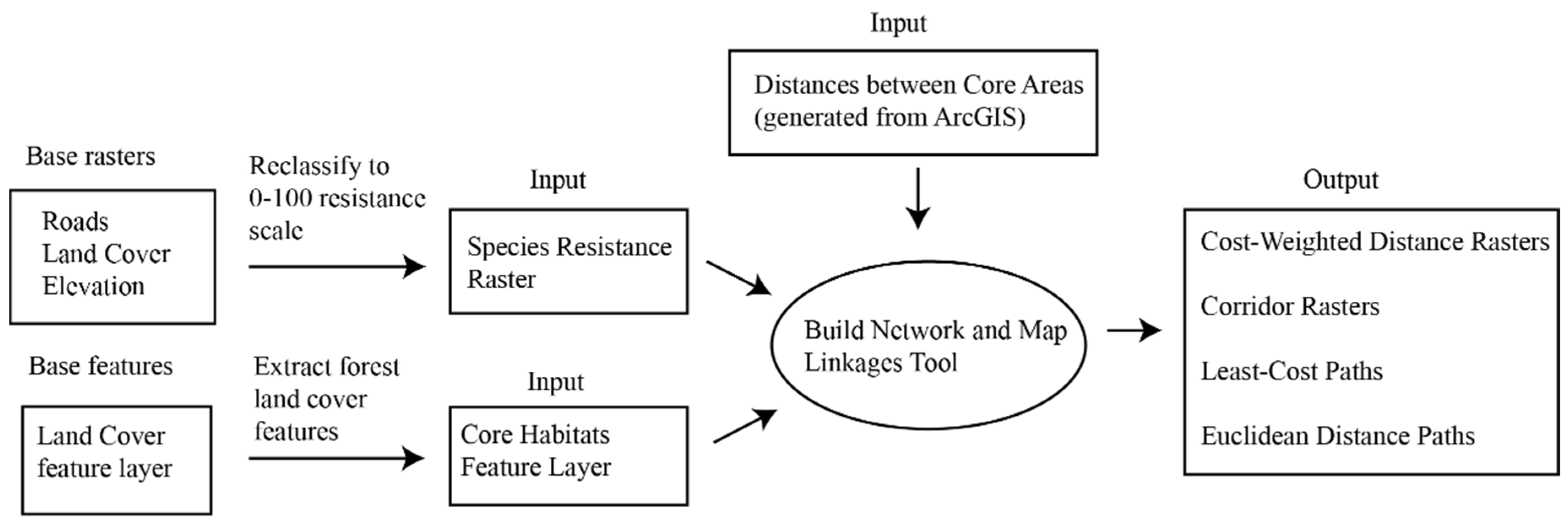

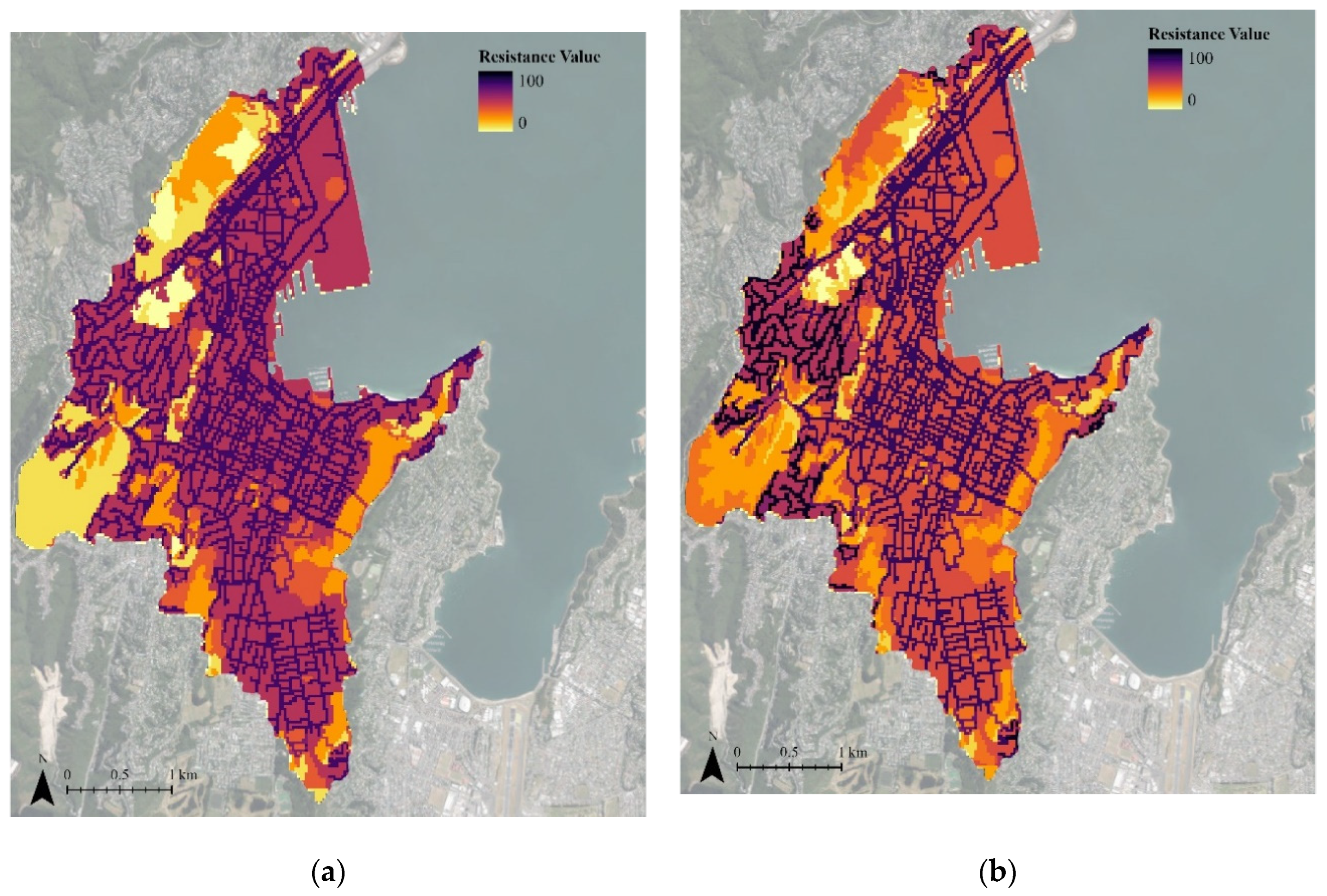
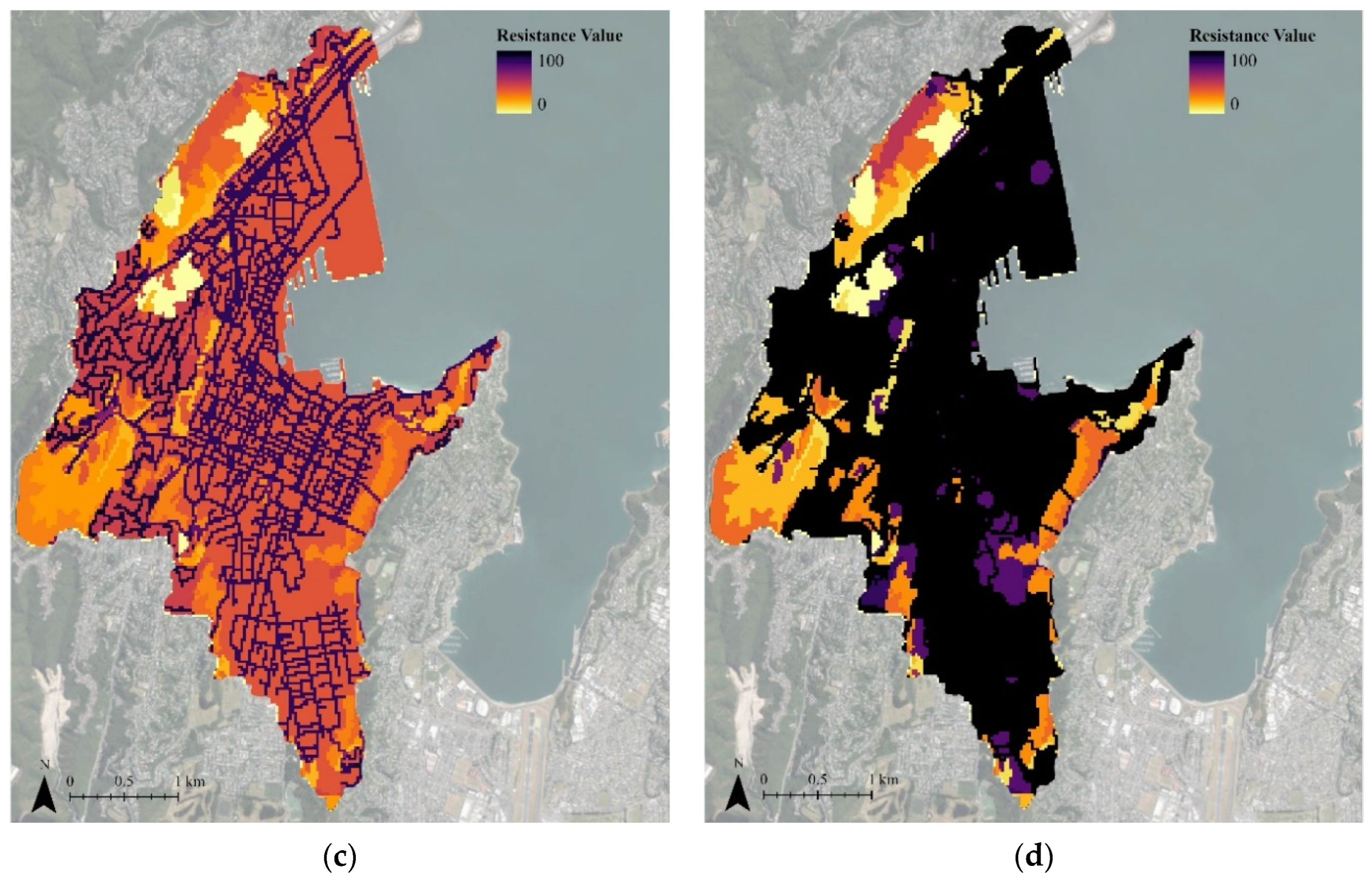
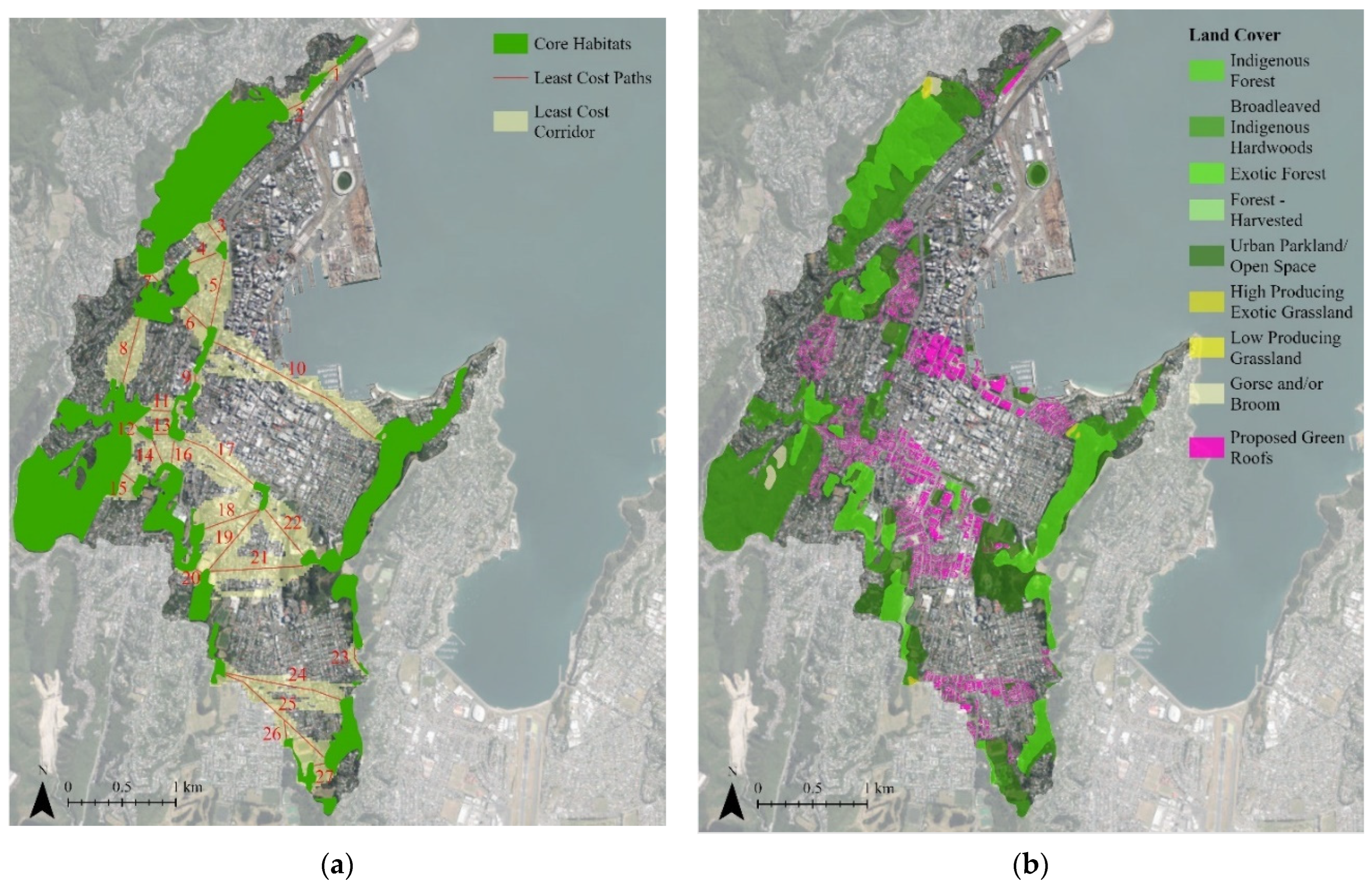
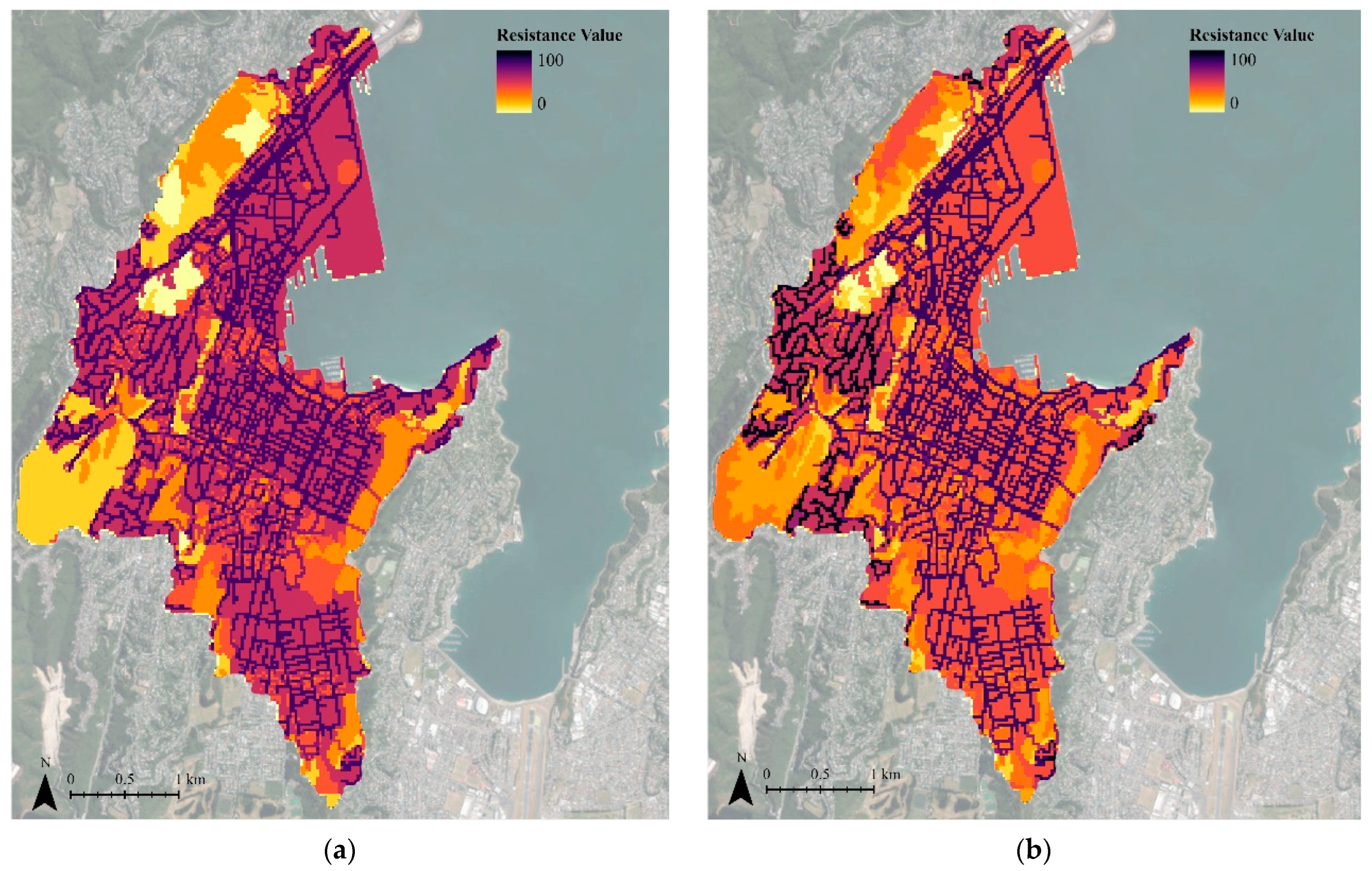



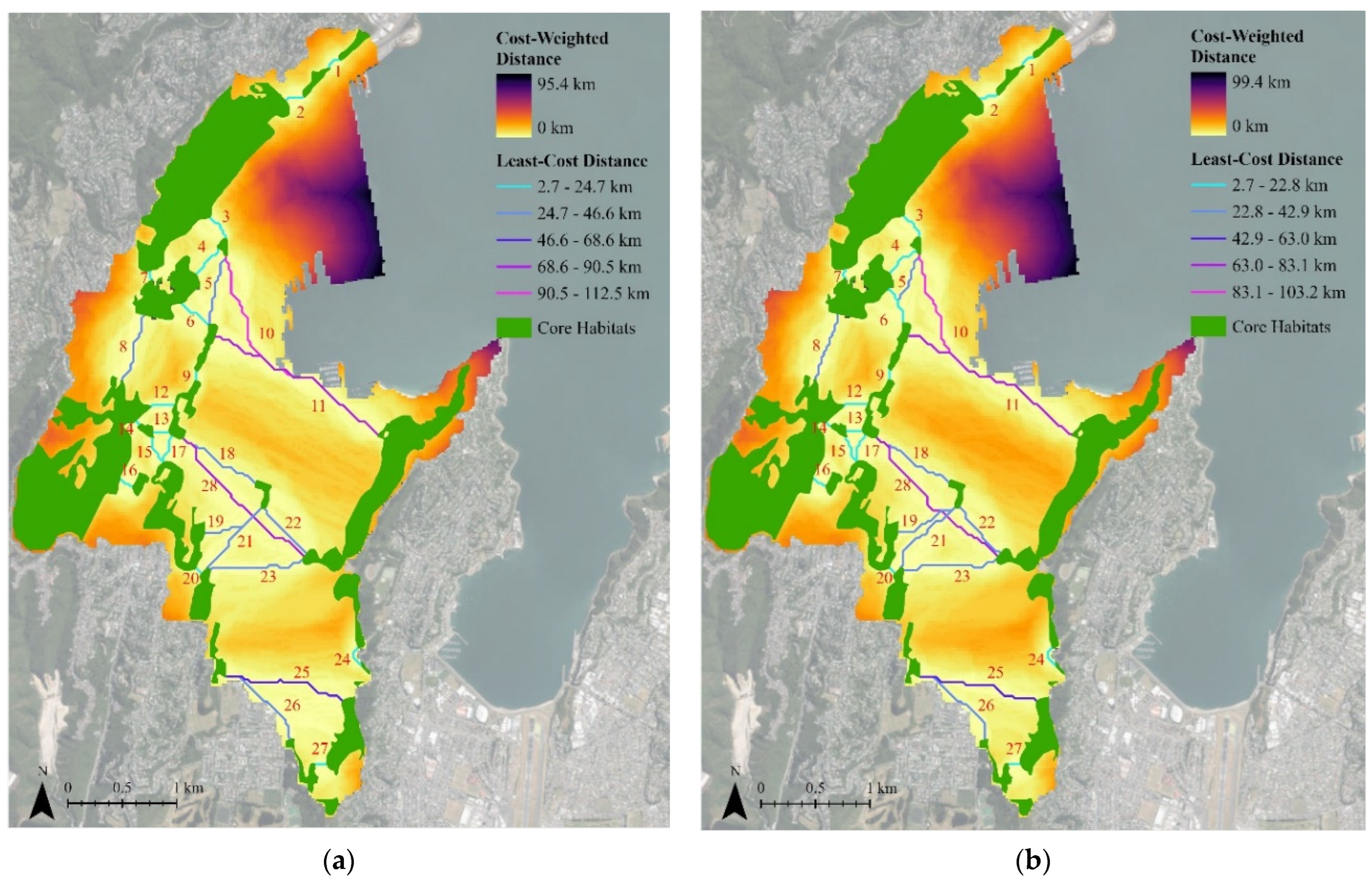
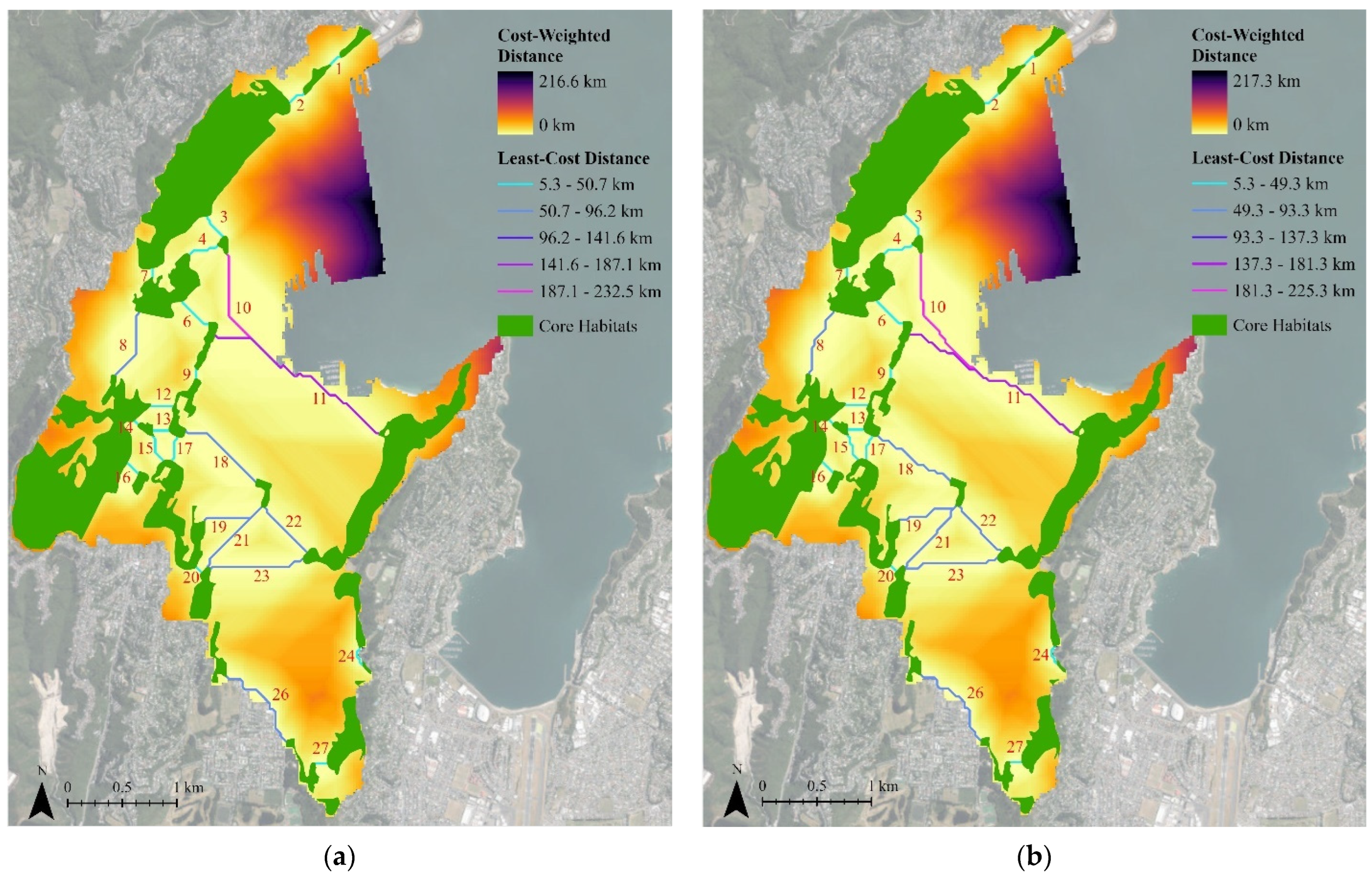
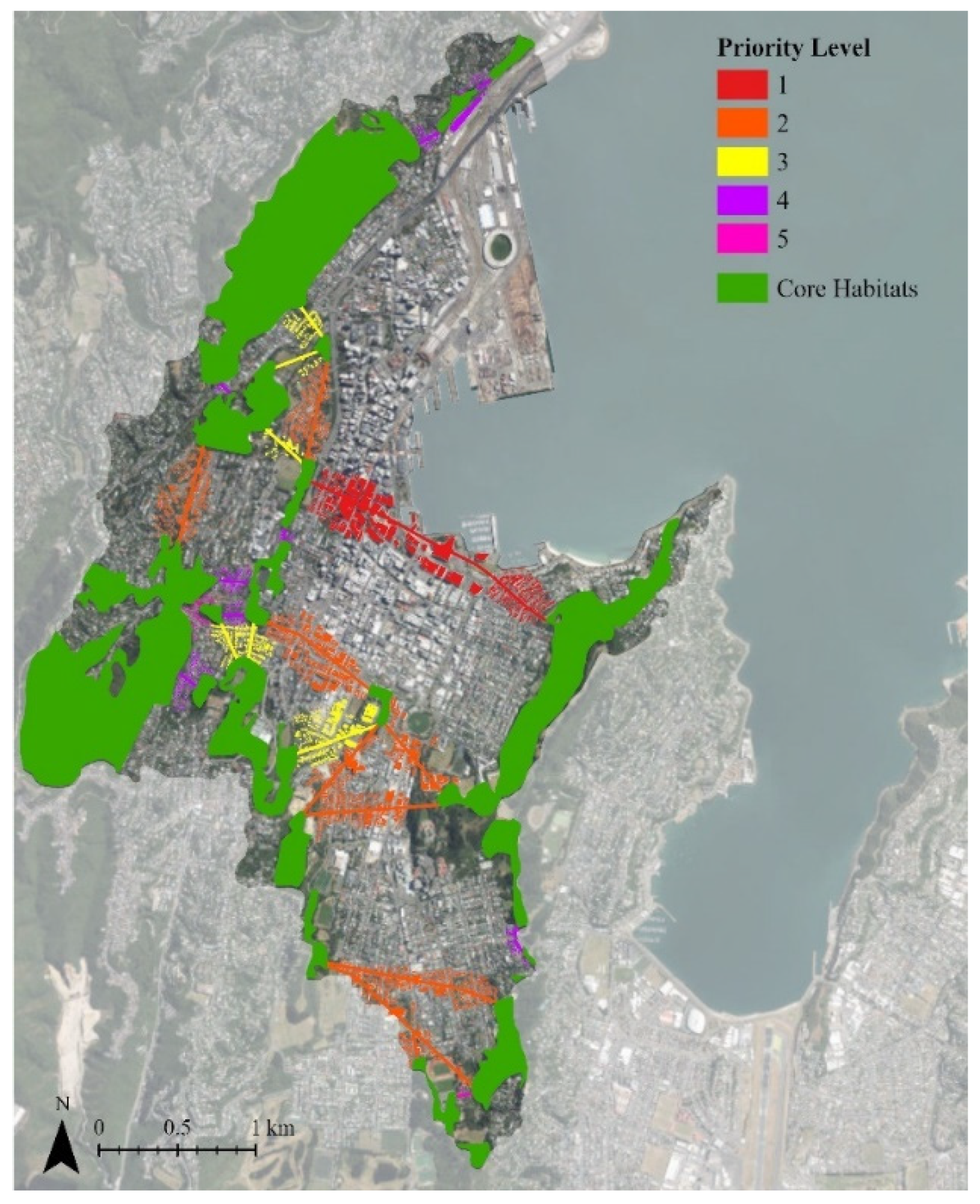
| Landscape Feature | Kererū | Tūī | Korimako | Hihi |
|---|---|---|---|---|
| Land Cover | ||||
| Built Area | 20 | 20 | 40 | 100 |
| Indigenous Forest | 0 | 0 | 0 | 0 |
| Broadleaved Indigenous Forest | 5 | 5 | 20 | 40 |
| Exotic/Harvested Forest | 10 | 10 | 30 | 50 |
| Urban Parkland/Open Space | 15 | 15 | 40 | 80 |
| Grassland | 10 | 10 | 35 | 70 |
| Gorse/Broom | 10 | 10 | 35 | 70 |
| Roads | 10 | 20 | 40 | 80 |
| Ground Elevation 1 | ||||
| 0–100 m | 0 | 0 | 0 | 5 |
| 100–200 m | 0 | 5 | 5 | 10 |
| 200–300 m | 0 | 10 | 10 | 20 |
Disclaimer/Publisher’s Note: The statements, opinions and data contained in all publications are solely those of the individual author(s) and contributor(s) and not of MDPI and/or the editor(s). MDPI and/or the editor(s) disclaim responsibility for any injury to people or property resulting from any ideas, methods, instructions or products referred to in the content. |
© 2023 by the authors. Licensee MDPI, Basel, Switzerland. This article is an open access article distributed under the terms and conditions of the Creative Commons Attribution (CC BY) license (https://creativecommons.org/licenses/by/4.0/).
Share and Cite
MacKinnon, M.; Pedersen Zari, M.; Brown, D.K. Improving Urban Habitat Connectivity for Native Birds: Using Least-Cost Path Analyses to Design Urban Green Infrastructure Networks. Land 2023, 12, 1456. https://doi.org/10.3390/land12071456
MacKinnon M, Pedersen Zari M, Brown DK. Improving Urban Habitat Connectivity for Native Birds: Using Least-Cost Path Analyses to Design Urban Green Infrastructure Networks. Land. 2023; 12(7):1456. https://doi.org/10.3390/land12071456
Chicago/Turabian StyleMacKinnon, Maggie, Maibritt Pedersen Zari, and Daniel K. Brown. 2023. "Improving Urban Habitat Connectivity for Native Birds: Using Least-Cost Path Analyses to Design Urban Green Infrastructure Networks" Land 12, no. 7: 1456. https://doi.org/10.3390/land12071456
APA StyleMacKinnon, M., Pedersen Zari, M., & Brown, D. K. (2023). Improving Urban Habitat Connectivity for Native Birds: Using Least-Cost Path Analyses to Design Urban Green Infrastructure Networks. Land, 12(7), 1456. https://doi.org/10.3390/land12071456










